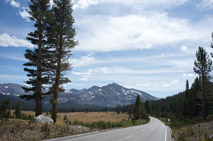9500' Is Not Sea Level, So Say My Lungs and Heart at Tioga Pass, Aerobic Energy at High Elevation
See my previous Race Prep for the Everest Challenge.
I’m acclimating to altitude in Yosemite high country for a few days. Today’s weather was not unlike that shown below; I rode one of my favorite Sierra rides cycling from Olmstead Point to Tioga Pass.
I live at an elevation of 500', and Tioga Pass is just shy of 10,000', with the Olmstead Point to Tioga Pass ride ranging from about 8,000' - 10,000' in elevation. Every time I visit, I notice much more rapid breathing, and today was no exception. Yet I am heartened by the fact that my first day at altitude showed higher power than last year by 20-30 watts. I do think I am in superior condition this year, at least in power-to-weight terms.
Hydration and physiological fluid loss
Aside from the effects of dryness which are relatively easily combatted with adequate fluid and a sinus rinse, I’ve found that there are interesting physiological changes that occur.
The observations here occurred both last year and this year and other trips when I stayed at altitude; they are consistent physiological effects which are to me interesting, and worthy of note to anyone acclimatizing:
- First night— large volume of fluid loss via urination, perhaps 50% more than usual. This is not due to intake of fluid which was modest and no different than usual.
- Day 1 and day 2 — normal patterns of urination and thirst.
- Day 3, approx 60 hours after first arriving at ~9500' — annoyingly high volume of fluid loss via urination resulting in a bed-time weight 4 pounds lower than normal, and morning weight 3 pounds lower. Urine is clear (little or no yellow). No unusual thirst or feeling or sign of dehydration (e.g. odiferous or concentrated urine).
Regarding #3 above, there was absolutely no sense of being dehydrated, and no feeling of thirst. It is my experience over the years that this fluid loss is associated with a physiological adaptation.
Aerobic energy at altitude
The oxygen approaching 10,000' is (going from memory here) about 20% less than at sea level. Since the lungs can take in the same volume of air regardless of altitude, the moles (quantiy) of oxygen available for aerobic energy production are thus reduced by ~20%, so the onset of anaerobic demands should occur at ~20% lower power levels (wattage) than at sea level. Since I am in peak aerobic condition, and I ride at quite high intensity levels aerobically, I notice such things with precision.
Checking my SRM power meter, I observed the onset of the lactate tingle at around 270 watts at 9700' elevation. At sea level, that won’t occur until about 340 watts, the difference being ~70 watts. Not surprisingly, the wattage difference is 70 watts, which is about 20% lower wattage than at sea level!
The foregoing is not a precise scientific study with blood draws for lactate or precise calculation of barometric pressure and thus oxygen content of air— it’s just to show that altitude and aerobic power are closely related, correlating more or less as would be expected since aerobic means “using oxygen” and the available oxygen decreases with altitude, thus lowering the maximum aerobic power (VO2).
With time spent at altitude, the body makes physiological adaptations which improve oxygen absorption (e.g. the blood composition changes to favor absorbing more oxygen from the same volume of air). This can be felt and measured in sustainable wattage. This is why I am in the mountains a week before the 2012 Everest Challenge, acclimating to altitude. I’ve trained hard all year (2 years really), so I’m not going to blow it by doing something dumb like showing up for the race a day or two before; at least for me, that gains are so substantial that they simply overwhelm any other minor differences in training or silly equipment approaches.









